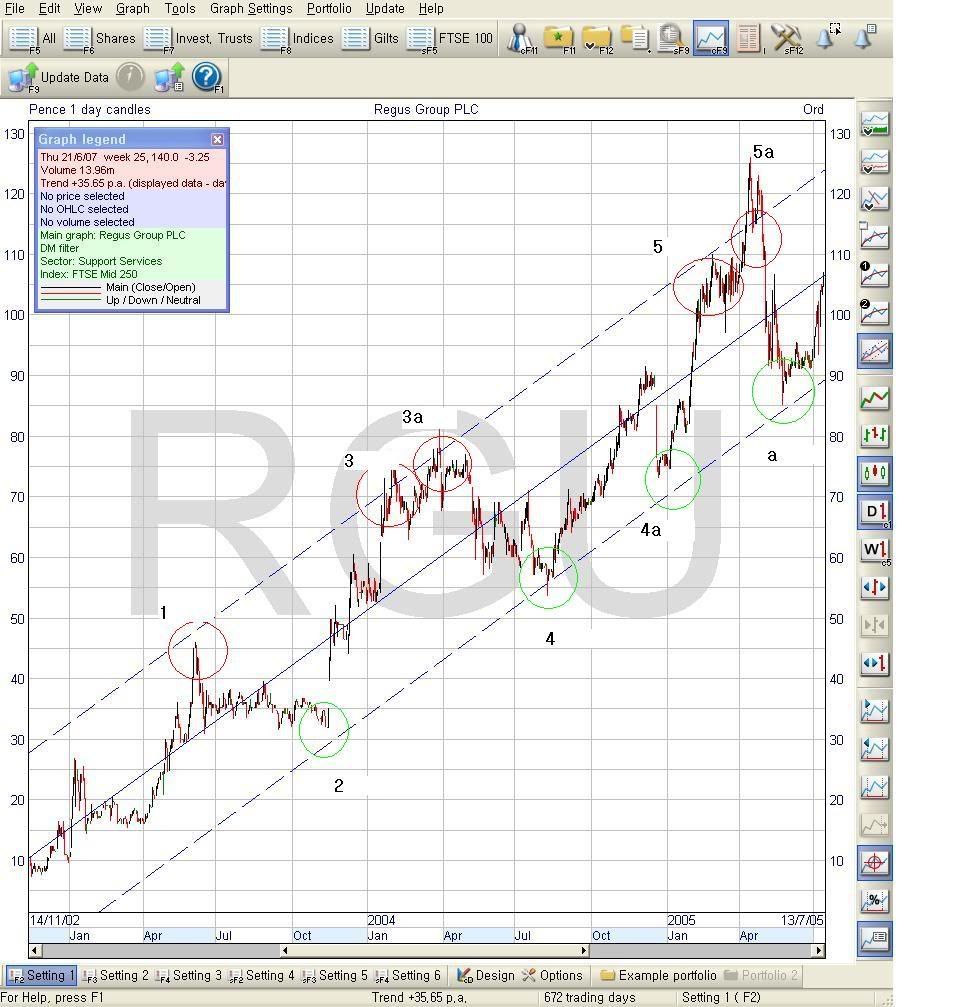I’ve found a stock (RGU) which looks to have some nice swings. Notice that this would be refered to as a "penny stock" in the US. It's currenctly trading around 80 pence. Penny stocks are sometimes avoided for various reasons in the US, but the price of a stock isn't really so relevant outside the US. Blue chips can be priced below a pound.

There was a nice uptrend beginning after the tech meltdown and lasting until Q2 2005 when it entered quite a wide trading range until the recent summer volatility during which is has tanked. This is a weekly chart using a daily scale, but markets are fractal allowing me to illustrate a basic concept.
I’ve drawn a basic trend line with channels either side 2 std devs away each side from the main trend. This is easy to do in the middle of the chart, but I’ll look for effective ways to quantify (or at least qualify) the trend and the channel when thinking about set-ups making it less ambiguous at the right edge of the chart.
I’ve drawn green circles around oversold (value) areas of the uptrend and red circle around overbought areas. The old adage “the trend is your friend” can be illustrated with this market trend. Assuming 2 trades in either direction:
Long:
2 – 3 (35p to 70p) = 35p move
4a – 5 (75p to 105p) = 30p move
TOTAL 65p
Short:
1 – 2 (45p to 35p) = 10p move
3a – 4 (75p to 55p) = 20p move
TOTAL 30p
So trading with the trend gives more than double the potential rewards here. Obviously only a fraction of each swing can be caught and perhaps most trades will lose money, but the basic concept remains valid.
This means I will be filtering out shorting signals during uptrends and long signals during downtrends. – Another basic fundamental but very important concept.
This stock appears to be following an Elliot Wave pattern during this uptrend. 1-2-3a-4-5a followed by the first retrace of the down-leg (a). The final leg (4a - 5a on this chart) being the most tradable move - but I’m not going to concern myself with market cycles at this point.
This next chart zooms in to the upleg 2 – 3 on the above chart.

Again there is the solid blue line representing the underlying trend with blue dashed confidence lines 2 standard deviations away – easy to draw in hindsight. This time I’ve overlaid a black 13-bar exponential moving average (EMA13). This EMA is enveloped by a channel drawn by shifting this EMA 20% in either direction. This isn’t a Bollinger Band as we are not yet concerned with volatility, but this EMA envelope can be modified later so that volatility data is used in its construction. Notice how wide this envelope is. The distance between the top and the bottom of the envelope represents approximately 40% of the value of the market, yet it contains around 90-95% of the market’s prices. An equity index’s envelope by comparison, might only be as wide as 4-5% of the market. A market with a wide trading envelope represent a bigger target from which we can extract profits with less room for error and a lesser impact from trading costs.
We can better see a similar patter being played out on a smaller scale. 3 legs up with 2 retraces in between. I haven’t labeled these #1-#5 as the chart is already a little cluttered. The green circles again show areas of value in an uptrend and the red circles show areas where the market might be temporarily overbought. The blue ovals show brief areas of potential consolidation which might lead to whipsaws and getting stopped out of losing trades. We can look for ways to limit these losses and potentially eliminate them to some degree through the use of filters – can be discussed further in the ‘set-ups’ sub-thread.
I think we need to be looking for entries in the green areas (below the EMA in an uptrend), looking for exits in the red areas (below the upper envelope in an uptrend) and looking for ways to preserve our capital in the blue areas (when the short-term trend become undefined).
Please make any suggestions that come to mind.